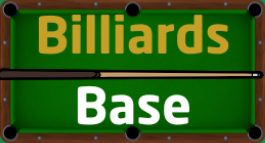Whether you’re shopping for your first pool table, visiting a new venue, or simply curious about the variations in cue sports, understanding the differences between English and American pool is essential.
These two distinct styles of play have evolved separately, creating unique equipment specifications, rules, and playing experiences that can significantly impact your enjoyment and skill development.
What is English Pool?
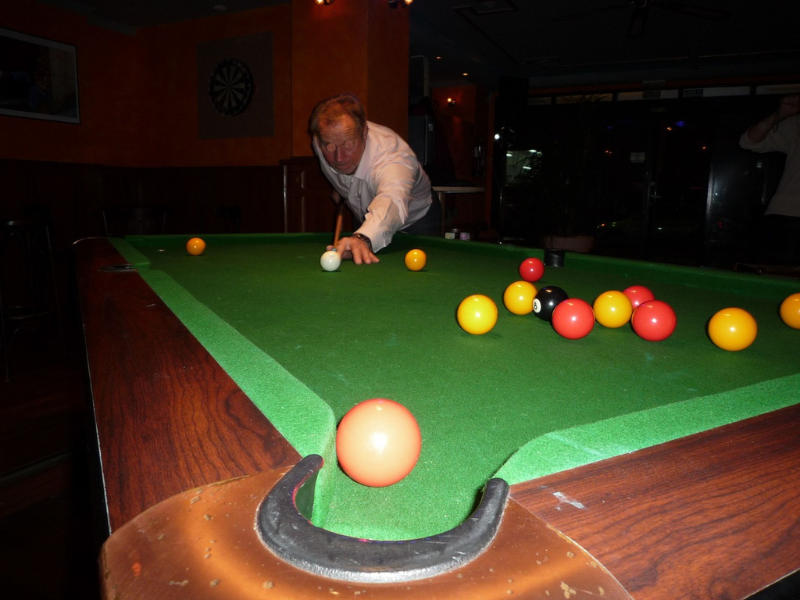
English pool, often simply called “pool” in the United Kingdom and many Commonwealth countries, originated from British billiards traditions and has become the dominant cue sport in UK pubs, clubs, and competitive venues. English pool rules emphasise precision, tactical play, and ball control on smaller tables.
The game typically uses red and yellow colored balls rather than numbered sets, with players attempting to pot all balls in their designated color group before legally potting the black ball to win the frame. English pool’s compact format makes it ideal for venues with limited space while still providing challenging, strategic gameplay.
Common rule sets include:
- Blackball Rules – Popular in European tournaments and many UK venues
- World Eightball Pool Federation (WEPF) “World Rules” – International standard for competitive play
- Local variations – Traditional pub rules that may vary by region
The smaller scale and tactical nature of English pool create a distinctly different playing experience compared to its American counterpart, with emphasis on defensive play, precise positioning, and careful shot selection.
What is American Pool

American pool, developed in the United States throughout the 19th and 20th centuries, has become the globally recognized standard for cue sports.
Played on larger tables with bigger balls and pockets, American pool emphasizes powerful breaks, long-distance shots, and dynamic gameplay that appeals to both casual players and serious competitors.
The most popular American pool variants include:
- 8-ball – Featuring striped and solid numbered balls (1-15)
- 9-ball – Sequential potting game using balls numbered 1-9
- 10-ball – Similar to 9-ball but with call-shot requirements
- Straight pool – Traditional points-based continuous play
Distinctive features of American pool halls include:
- Larger playing spaces accommodating 9-foot tables
- Tournament-style lighting and seating arrangements
- Spectator areas for competitive events
- Professional-grade equipment standards
American pool rules allow for more dramatic shot-making, longer runs, and spectacular break shots that have made it popular in televised competitions and international tournaments.
Key Equipment Differences
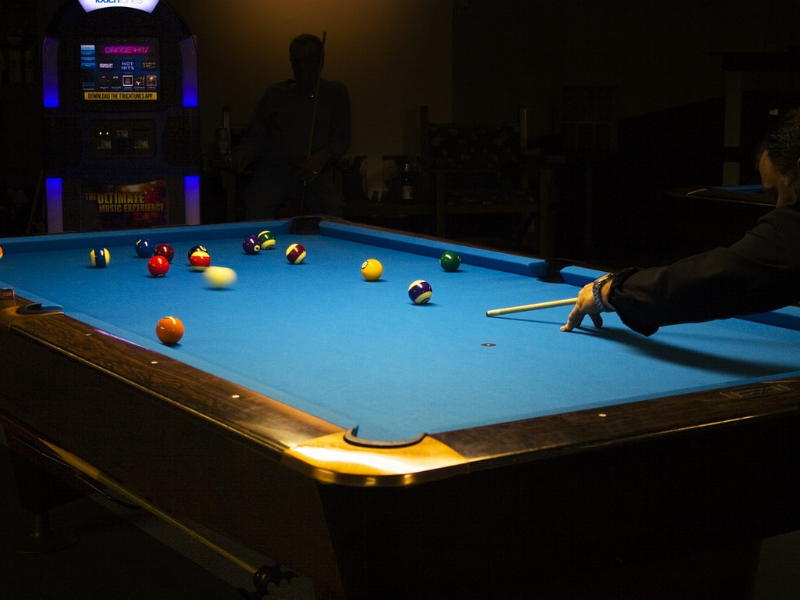
Table Size and Pockets
The most immediately noticeable difference between English and American pool lies in table dimensions and pocket specifications:
English Pool Tables:
- Length: Typically 6-7 feet (most commonly 7ft)
- Width: 3.5 feet (half the length)
- Pocket size: Smaller, more challenging pockets
- Rail height: Lower profile rails
American Pool Tables:
- Length: 7, 8, or 9 feet (9ft standard for tournaments)
- Width: 4-4.5 feet (half the length)
- Pocket size: Larger, more forgiving pockets
- Rail height: Higher profile cushions
| Specification | English Pool | American Pool |
| Standard Length | 7 feet | 9 feet |
| Width | 3.5 feet | 4.5 feet |
| Pocket Size | 3.5″ – 3.75″ | 4.5″ – 5″ |
| Playing Surface | 76″ × 38″ | 100″ × 50″ |
| Height | 32″ – 33″ | 31″ – 32″ |
Impact on gameplay: The smaller English table demands greater precision and ball control, while larger American tables allow for more powerful shots and longer positional play.
Ball Size and Color
Ball specifications create fundamental differences in playing characteristics:
English Pool Balls:
- Diameter: 2 inches (50.8mm) or 1⅞ inches (47.6mm)
- Weight: Approximately 4.5-5 ounces
- Colors: Seven red, seven yellow, one black ball
- Surface: Often matte or semi-gloss finish
American Pool Balls:
- Diameter: 2¼ inches (57.2mm)
- Weight: Approximately 5.5-6 ounces
- Design: Numbered 1-15 with stripes and solids
- Surface: High-gloss phenolic resin finish
The smaller English balls require more precise cue control and create tighter groupings on the table, while larger American balls provide more momentum and forgiveness for less precise contact.
Cue Differences
Cue specifications are optimized for each playing format:
English Pool Cues:
- Tip diameter: 8-9mm (approximately 0.31-0.35 inches)
- Weight: 17-19 ounces
- Length: 54-57 inches
- Wood: Often ash wood with brass fittings
- Taper: Gradual, allowing precise control
American Pool Cues:
- Tip diameter: 12-13mm (approximately 0.47-0.51 inches)
- Weight: 19-21 ounces
- Length: 58-59 inches
- Wood: Typically hard maple construction
- Taper: More pronounced taper for power shots
The thinner English cue tips provide enhanced accuracy for precise shots on smaller balls, while thicker American tips deliver more power and English (spin) transfer suitable for the larger playing surface.
Rules and Gameplay Differences
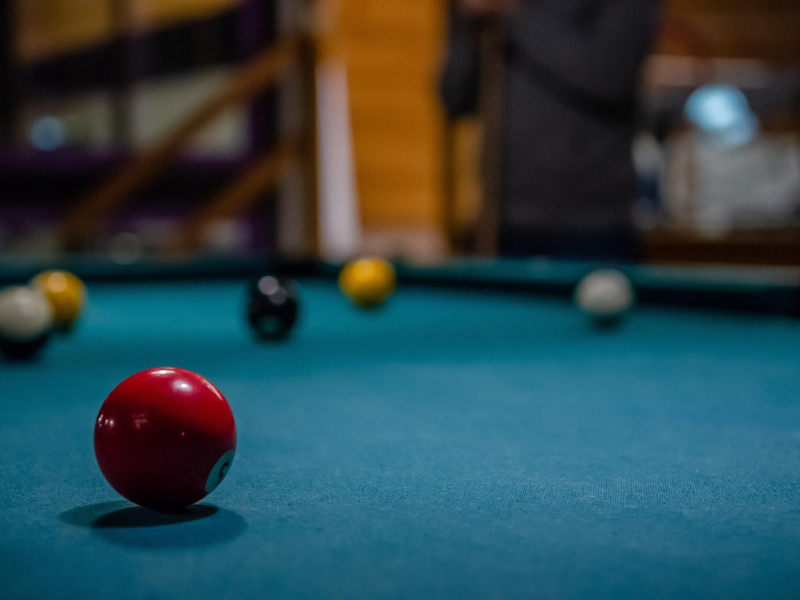
English Pool Rules (Blackball / World Rules)
English pool rules emphasize skill-based play with specific requirements:
Basic Gameplay:
- Groups: Players claim red or yellow balls based on first legal pot
- Nomination: Must nominate target ball and pocket (World Rules)
- Finish: Pot all group balls, then legally pot the black ball
- Break: Must pot a ball OR drive 2+ balls plus cue ball to cushions
Key Rule Features:
- “Two shots” rule: Most fouls award opponent two consecutive visits
- Skill shots: Must demonstrate intention and control
- Combination shots: Legal during “open table” period
- Safety play: Defensive shots encouraged and rewarded
Common Fouls:
- Failing to hit group ball first
- Potting cue ball or opponent’s balls
- Failing to drive any ball to cushion when none potted
- Touching balls with hands, cue, or clothing
American Pool Rules
American pool rules vary by specific game type but share common elements:
8-Ball Rules:
- Groups: Stripes (9-15) vs. solids (1-7)
- Call shots: Must call obvious shots in many venues
- Break requirements: Open break with specific ball/cushion requirements
- 8-ball rules: Must be potted last in called pocket
9-Ball Rules:
- Sequential: Must contact lowest numbered ball first
- Winning: Pot the 9-ball at any time after legal contact
- Push-out: Special rule allowing repositioning after break
Foul Penalties:
- Ball-in-hand: Cue ball may be placed anywhere on table
- Loss of turn: Standard penalty for most infractions
- Loss of game: Specific violations involving the money ball
| Aspect | English Pool | American 8-Ball |
| Penalty System | Two shots | Ball-in-hand |
| Shot Calling | Required (World Rules) | Obvious shots only |
| Group Assignment | First legal pot | Player choice after break |
| Combination Shots | Allowed when open | Generally allowed |
| Money Ball Fouls | Loss of frame | Loss of game |
Game Experience: Style, Speed, and Strategy
The different equipment and rules create distinctly different playing experiences:
English Pool Characteristics:
- Pace: Generally slower, more methodical
- Strategy: Heavy emphasis on safety play and snookering
- Skill focus: Precise ball control and positional play
- Atmosphere: Often social, pub-oriented environment
- Shot selection: Careful consideration of defensive options
American Pool Characteristics:
- Pace: Faster, more dynamic gameplay
- Strategy: Emphasis on run-out play and pattern recognition
- Skill focus: Power, spin control, and long-distance accuracy
- Atmosphere: Competitive pool hall or tournament environment
- Shot selection: Aggressive offensive play preferred
Beginner Considerations:
- English pool: Smaller table easier for learning fundamentals
- American pool: Larger pockets more forgiving for developing players
- Skill transfer: Both games develop valuable cue sports abilities
- Equipment costs: English setup generally requires less space and investment
Cultural Differences: English pool’s pub culture encourages social interaction and casual competition, while American pool halls often focus on serious practice of advanced pool drills and tournament preparation.
Which Table and Game Should You Choose?
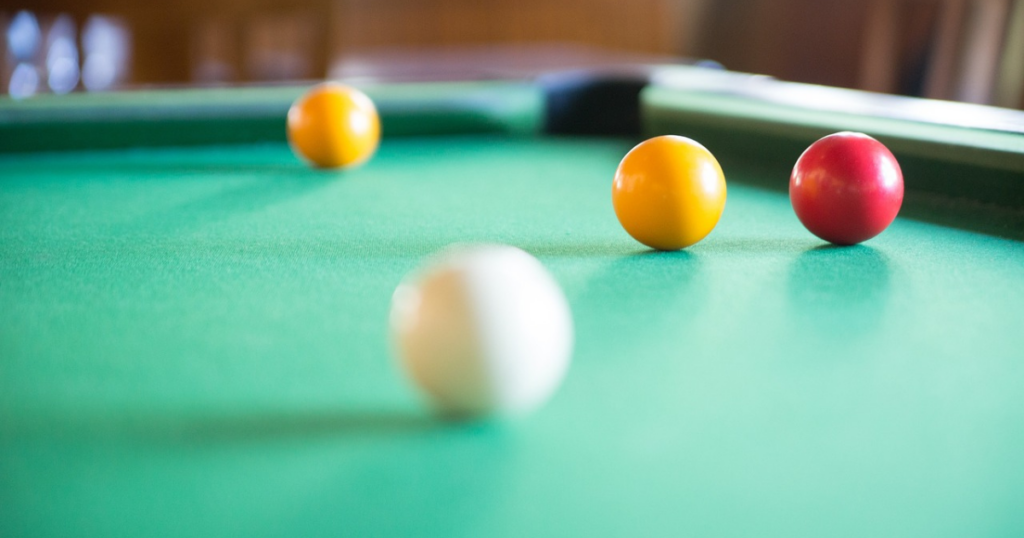
Consider these factors when deciding between English and American pool:
Space Requirements:
- English table: Requires approximately 12′ × 9′ room minimum
- American table: Needs approximately 14′ × 11′ room minimum
- Cue clearance: Add 5 feet on all sides for comfortable play
Player Considerations:
- Beginners: English smaller table easier to learn, American larger pockets more forgiving
- Families: English compact size suitable for homes, American better for serious players
- Skill development: Both formats develop valuable transferable abilities
Budget Factors:
- Initial cost: English tables generally less expensive
- Accessories: English balls and cues typically cost less
- Maintenance: Similar ongoing costs for both formats
Decision Checklist:
- ✓ Measure available space accurately
- ✓ Consider primary users and skill levels
- ✓ Determine preferred playing style (tactical vs. power)
- ✓ Research local venues and leagues for each format
- ✓ Budget for table, accessories, and installation
Frequently Asked Questions (FAQs)
What is the main difference between English and American pool?
The primary differences are table size (English: 7ft vs American: 9ft), ball size (English: 2″ vs American: 2¼”), and rules structure (English emphasizes tactical play with two-shot penalties, while American focuses on offensive run-out play with ball-in-hand penalties).
Can I play English pool on an American table or vice versa?
While physically possible, the experience significantly differs due to scale. English pool on American tables feels unusually spacious and easy, while American pool on English tables becomes cramped and difficult. Equipment compatibility also varies—American balls may not fit properly in English table pockets.
Why are English pool balls smaller?
Smaller balls complement the compact playing surface and tighter pockets, creating a game that emphasizes precision over power. The 2″ diameter provides optimal proportions for the 7-foot table while maintaining challenging gameplay.
Are the cues interchangeable between formats?
While possible, cues are optimized for specific formats. English cues’ thinner tips (8-9mm) work well on smaller balls but may lack power for American tables. American cues’ thicker tips (12-13mm) can feel clumsy on smaller English balls and tighter shots.
Which game is considered harder?
Both formats present unique challenges. English pool demands exceptional precision and tactical thinking due to smaller targets and tighter spaces. American pool requires powerful break shots, long-distance accuracy, and complex positional play. Many professionals excel at one format while struggling with the other.
Can learning one format help with the other?
Yes, fundamental skills like cue action, aiming, and basic strategy transfer between formats. However, specific techniques like speed control, power application, and tactical approaches require format-specific practice to master.
Pick the Pool Version for You
Understanding the distinctions between English and American pool helps you make informed decisions about equipment, learning priorities, and playing opportunities. Each format offers unique rewards: English pool’s tactical depth and precision requirements, versus American pool’s dynamic power play and spectacular shot-making potential.
Key takeaways:
- Equipment scales directly impact playing style and skill requirements
- Rule differences create distinct strategic approaches and penalty systems
- Cultural contexts influence playing atmosphere and competitive structures
- Space and budget considerations often determine practical choices
The most comprehensive approach involves experiencing both formats when possible. Many players discover unexpected preferences, and cross-training between formats can accelerate overall skill development.
Whether you choose the tactical precision of English pool or the dynamic power of American pool, both formats offer lifetime learning opportunities and competitive enjoyment.
Next Steps
- Visit local venues offering both formats to experience the differences firsthand
- Consult equipment guides for specific recommendations on tables, balls, and cues
- Join leagues or clubs to develop skills in your preferred format
- Study official rules to understand competitive standards and requirements
Equipment specifications and rule interpretations may vary by manufacturer and venue. Always verify current standards with official governing bodies for competitive play.
